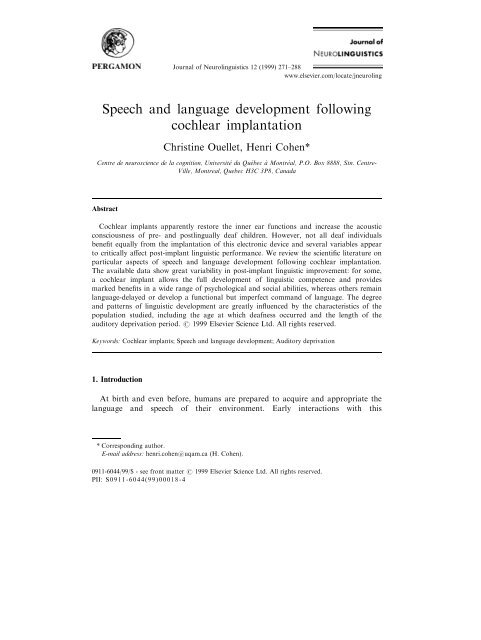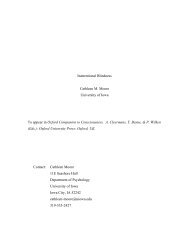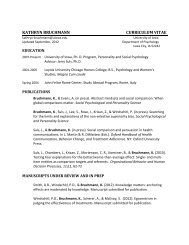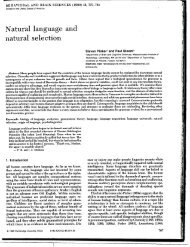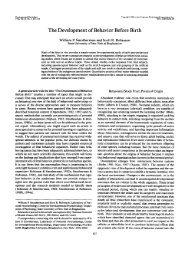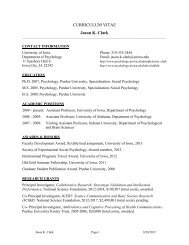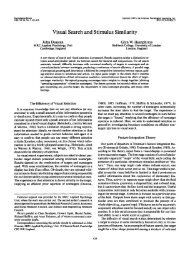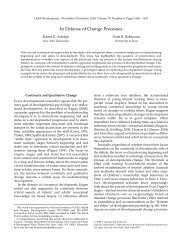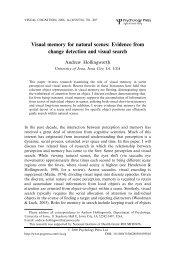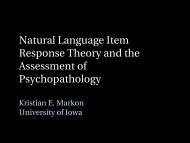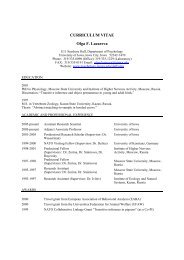Speech and language development following ... - ResearchGate
Speech and language development following ... - ResearchGate
Speech and language development following ... - ResearchGate
- No tags were found...
Create successful ePaper yourself
Turn your PDF publications into a flip-book with our unique Google optimized e-Paper software.
C. Ouellet, H. Cohen / Journal of Neurolinguistics 12 (1999) 271±288 273Language <strong>development</strong> appears to be based on relatively plastic neural systemsthat are also used for other cognitive <strong>and</strong> perceptual functions [4]. But children<strong>and</strong> adults do not necessarily use the same neural resources for <strong>language</strong>perception <strong>and</strong> production <strong>and</strong> some parts of the brain may be more active incertain kinds of linguistic activities over time. Locke [37] assigns early vocallearning <strong>and</strong> utterance acquisition to the right hemisphere whereas, in oldersubjects, the left hemisphere is dominant for everything related to lexicalcomprehension, expression, syntax <strong>and</strong> grammar tasks. One follow-up study hasshown that the linguistic abilities of a left-hemispherectomized child were similarto those of <strong>language</strong>-impaired children whereas the linguistic competencies of aright-hemispherectomized child resembled those of <strong>language</strong>-normal children [75].In the same way, school-age children with left hemisphere lesions show morediculties with <strong>language</strong> than those with right hemisphere lesions, althoughproblems in <strong>language</strong> <strong>development</strong> may occur in both groups. These resultsprovide indirect support for innate specialization <strong>and</strong> plasticity as well as for theinvolvement of the right hemisphere in <strong>language</strong> acquisition <strong>and</strong> verbal cognition[49].Experience may also in¯uence cerebral organization <strong>and</strong> activity. Dehaene et al.[17] found some anatomical variability in the cortical representation of ®rst <strong>and</strong>second <strong>language</strong>s. Subjects who listened to stories in their ®rst <strong>language</strong> showedactivation of the left temporal lobe, especially in the areas along the left superiortemporal sulcus, whereas those who listened to stories in their second <strong>language</strong>showed activity in varying left <strong>and</strong> right temporal <strong>and</strong> frontal areas, sometimesrestricted to right hemisphere regions.The central auditory system may also experience a functional reorganization<strong>following</strong> changes in auditory stimuli, leading to linguistic improvement [70].Volumetric measurements of the planum temporale, contained in the perisylvianarea, which has been implicated in <strong>language</strong> <strong>development</strong>, have revealed that thisarea is already larger on the left than on the right side in the fetal brain.Following auditory deprivation, which results in inactivation of the neurolinguisticmechanisms, a compensatory hypertrophy of the homologous right hemispherestructures may develop as a result of a general neuromaturational delay. The righthemisphere would then control linguistic parameters that were previously underthe left hemisphere's domination. There is a functional shift to intact brainstructures at that time. According to Locke [37], this adaptive but unusual brainorganization produces a functional but imperfect comm<strong>and</strong> of <strong>language</strong>. Pontonet al. [61] suggest instead that the auditory system does not mature withoutstimulation. They showed that the maturational processes of the cortical auditorysystem, which do not progress during a period of deafness, resume after acousticstimulation is reintroduced. However, Truy et al. [80] found that the ascendingauditory pathways remain operational long after prelingual deafness <strong>and</strong> that theauditory cortex can be activated by electrical stimulations of the cochlea evenwithout perception of environmental sounds. In their study, subjects showedincreased auditory cortex activity during electrical cochlear stimulation.
3. Cochlear implantsC. Ouellet, H. Cohen / Journal of Neurolinguistics 12 (1999) 271±288 275Cochlear implants are computerized devices that restore speci®c functions to thecochlea. They are designed for patients with bilateral profound to total deafnesswho receive little or no bene®t from sound ampli®cation [10]. They are also usefulfor the rehabilitation of patients with residual hearing <strong>and</strong> some speechunderst<strong>and</strong>ing [67]. These electronic devices enable the stimulation of thevestibulocochlear nerve via the electrical current they generate from the acousticvibrations [81]. This electrical stimulation of undamaged ®bres of the cochlearnerve can restore hearing when all hair cell function is lost <strong>and</strong> there is nopossibility of speech discrimination with hearing aids. The device consists of (1) amicrophone that picks up <strong>and</strong> sends auditory stimuli to (2) an external processorthat transforms the mechanical acoustic wave into an electric signal <strong>and</strong> (3) anelectrode array implanted near the auditory nerve [46]. A system of induction coilsallows for the electrical connection across the skin between the implantedelectrodes <strong>and</strong> the processor. Fig. 1 is a schematic representation of the cochlearimplant <strong>and</strong> auditory system.Cochlear implants may be single- or multichannel. The latter enhance lipreading<strong>and</strong> permit discrimination of speech without vision in the majority ofcases [24]. A comparison of implant systems showed that the multichannelprostheses permitted correct transmission of a larger number of acoustic stimuli<strong>and</strong> enabled greater speech reading abilities as well as open-set speech recognition.The implant systems most used by deaf patients nowadays are the Nucleusdevice, the Ineraid <strong>and</strong> the Clarion system. The ®rst two are second-generationimplants whereas the Clarion device is a more modern, third-generation system.The 22-channel Nucleus implant is the only intracochlear device licensed for use inchildren by the American Food <strong>and</strong> Drug Administration [23]. Children withmeningitis or cochlear ossi®cation who become deaf between the ages of 18 <strong>and</strong>23 months can be implanted with the Clarion system. This third-generation device,introduced in 1993, contains 16 electrodes arranged into 8 bipolar pairs thatoperate simultaneously or sequentially. It is also the ®rst device to o€er a choiceof processing strategies in one processor [11]. Moreover, Tyler <strong>and</strong> Summer®eld[86] found better performance in word identi®cation with a Clarion group of deafpatients than with Ineraid <strong>and</strong> Nucleus groups; the latter two groups performed ata comparable level. Other devices have also been developed (e.g. the AustrianMed-El multichannel prostheses <strong>and</strong> the Digisonic <strong>and</strong> Laura multichanneldevices developed in France <strong>and</strong> Belgium, respectively) which can apparentlyenhance speech underst<strong>and</strong>ing without lip-reading [11].The external speech processor hardware <strong>and</strong> software of a cochlear implant canbe adjusted to suit an implant user's preferred speech-processing strategies. Thesedi€erences in usage of an identical device may be due to di€erences in the etiologyof the patients' deafness or in the way their central nervous system originallylearned to decode the cues necessary to discriminate speech sounds [38]. <strong>Speech</strong>coding strategies are thus parameters of implant systems that may a€ect thelinguistic performance of both adult <strong>and</strong> child users. The single-channel cochlear
C. Ouellet, H. Cohen / Journal of Neurolinguistics 12 (1999) 271±288 277system <strong>and</strong> <strong>language</strong> acquisition <strong>development</strong> [34] <strong>and</strong> the negative correlationbetween age at onset of deafness <strong>and</strong> the <strong>development</strong> of speech perception,speech production <strong>and</strong> <strong>language</strong> competence <strong>following</strong> an implantation, it is clearthat younger children can derive signi®cant bene®ts from an implant [44]. Despiteobjections concerning biosafety problems such as head <strong>and</strong> temporal bone growth,otitis media, device extrusion or migration <strong>and</strong> the diculty of estimating theresidual hearing, or any other h<strong>and</strong>icap, of young patients [34], clinical experience<strong>and</strong> laboratory data strongly suggest that cochlear implantation is possible beforethe age of two [25]. Implantation may also result in better speech perception <strong>and</strong>overall linguistic performance in children as young as 16 months [58], probablybecause it reduces the <strong>language</strong> <strong>development</strong> delay.Although there are no age restrictions in terms of onset of deafness, the issue ofan upper age limit for this surgical operation is often debated. It has been arguedthat the decision to implant should be based solely on whether the patient's healthallows such a surgical intervention [44]. It has been shown that there are nosigni®cant di€erences in performance on closed-set tests of speech perceptionability between prelingually deafened children implanted before or after the age of®ve Ð even though the former performed better on open-set word recognition[19]. However, prelingually deaf children implanted after 12 years of age, whohave practiced <strong>and</strong> established a manual communication system, may show alower response <strong>following</strong> implantation. Although the procedure should not bedenied, Tyler et al. [84] do not recommend it for such patients.The criteria for implantation c<strong>and</strong>idacy have relaxed since the establishment ofthe ®rst national clinical trial of single-channel cochlear implants in 1979 [5].Initially, only deaf patients with bilateral profound sensorineural hearing loss whowere not able to perform open-set listening were considered for such an operation.Until 1991, no patients performing over 20% correct with conventionalampli®cation on open-set tests were implanted [91]. Recently, the US Food <strong>and</strong>Drug Administration approved the c<strong>and</strong>idacy of hearing-impaired adults withbinaural open-set sentence recognition scores no greater than 30% correct for theNucleus device [11]. According to Yaremko <strong>and</strong> Gibson [91], good hearing aidusers obtaining correct scores of between 30% <strong>and</strong> 50% on open-set tests shouldnot be automatically rejected. However, patients must be aware that any residualhearing in the implanted ear will likely be destroyed by the electrode insertion,thus precluding future use of a hearing aid in that ear.Patient selection is ®nally determined through audiological, medical <strong>and</strong>psychological assessments. During the audiological evaluation, the unaided <strong>and</strong>aided thresholds using conventional ampli®cation are established [44], giving ameasure of the functional hearing aid bene®t <strong>and</strong> allowing one to choose the earto be implanted - which is often the most a€ected one. The medical examinationincludes the otological history, the physical examination <strong>and</strong> the radiologicalevaluation of the cochlea. The etiology of the deafness may be determined in thisway. An otologically stable condition must be present to consider the feasibility ofthis surgical operation, which means an intact tympanic membrane <strong>and</strong> theabsence of infection or otitis media. Medical or surgical treatment prior to the
278C. Ouellet, H. Cohen / Journal of Neurolinguistics 12 (1999) 271±288intervention may be required to meet these conditions. The cochlea is alsoexamined to detect any malformation or intracochlear ossi®cation. Finally,exclusionary factors may be identi®ed in the psychological assessment, such asundetected psychosis, organic brain dysfunction or mental retardation.5. Mediating factorsSeveral factors appear to in¯uence the bene®ts of a cochlear implantation <strong>and</strong>help explain, alone or in combination, the large between-subject di€erences inimplant outcome <strong>and</strong> the variance in patients' linguistic improvement. Amadori etal. [1] de®ned a number of predictors concerning a broad range of linguisticperformances: (1) age at onset of deafness, with postlingual patients being moreecient than prelingual ones; (2) duration of deafness, with better results beingassociated with a shorter period of deafness; <strong>and</strong> (3) length of electrode insertion<strong>and</strong> activation, with poorer performance usually being associated with fewer than10 active electrodes. For other researchers, the most important predictive factorsare auditory nerve survival [44] <strong>and</strong> responsiveness of the central nervous system[86].A moderate correlation between speech recognition performance in adults <strong>and</strong>electrical thresholds, dynamic ranges <strong>and</strong> the number of active electrodes has beennoted [20,28], whereas patients' willingness <strong>and</strong> motivation were also found to bestrongly associated with speech underst<strong>and</strong>ing [20,30]. Visual informationprocessing skills, knowledge of nonverbal communication strategies <strong>and</strong> activemanagement of one's healthcare are further factors, alone or in combination, thatcould account for the variability in postoperative scores [21]. Finally, there isapparently no relationship between IQ alone <strong>and</strong> implant outcome.It might be expected that post-implant linguistic abilities would depend uponthe age at which someone went deaf. However, Osberger et al. [55] did not ®nddi€erences in speech perception performance between children born deaf(congenitally deafened) <strong>and</strong> those deafened before the age of 3 (prelinguallydeafened children). They only ®nd signi®cantly better skills on tests of stresspattern, closed- <strong>and</strong> open-set discrimination in children deafened after the age of5. In contrast to these results, Nikolopoulos et al. [50] found lower scores inprelingually deaf children compared to congenitally deaf children on a scaleassessing the developing use of post-implant audition. Ito et al. [27] demonstrateda delayed speech comprehension performance in prelingually deaf patientscompared with postlingually deaf ones; nevertheless, the former group alsoprogress in the ®rst years after implantation, at a slower but still continuous rate[33].The age at which patients are implanted is also a critical variable. Prelinguallydeafened c<strong>and</strong>idates implanted in adolescence or adulthood do not score abovechance levels on word <strong>and</strong> sentence identi®cation tests without lip-reading. Thismay be due to their lifestyle <strong>and</strong> manual communication experience, to social <strong>and</strong>cultural in¯uences <strong>and</strong>/or to the e€ects of longer auditory deprivation since birth
C. Ouellet, H. Cohen / Journal of Neurolinguistics 12 (1999) 271±288 279[8,14]. There may also be a trend towards non-use of the device in patientsimplanted during adolescence [46]. However, Summer®eld <strong>and</strong> Marshall [76] failedto replicate this association between age at implantation <strong>and</strong> performance.Duration of deafness has been found to have the most robust association withperipheral (the number of ganglion cells) <strong>and</strong> central determinants (responsivenessof the nervous system, potential for relearning <strong>and</strong> memory for sounds of speech)of good performance with the device [86]. Subjects with a shorter duration ofauditory deprivation tended to perform better on tests of speech perception thanthose with longer periods of deafness [72,73]. However, this factor has been foundto account for only about 20% of the speech underst<strong>and</strong>ing variance [86].Finally, experience with implant usage will also determine the course ofimprovement of response to the device over time. Implant performance is usuallymeasured between one week <strong>and</strong> one month after device activation Ð this is thetime required to program the processor optimally [86]. <strong>Speech</strong> perception maysigni®cantly improve after 6, 12 <strong>and</strong> 24 months of implant use [89]. Recognitionperformance generally increases over the ®rst 9 months of implant experience <strong>and</strong>about half of this improvement occurs within one month of implantation. Thetime frame for improvements in performance with second-generation implantsystems may extend over 2 or 3 years, with large individual di€erences observed inthe pattern of performance evolution [86]. For instance, data suggest thatimprovements in closed-set recognition do not occur before 1 year of implant usein prelingually deafened children; open-set speech recognition takes even longer[18,45,88] because of the complex linguistic <strong>and</strong> auditory processes involved.However, Staller et al. [74] found signi®cant improvements in speech perceptionskills after only 6 months of device experience. As for speech production, it mayincrease throughout the ®rst 4 months but progress slows down at 1 year.However, the possible rapid improvements from day 1 to days 30 <strong>and</strong> 120 in aprelingually deaf group suggest that cochlear implants allow immediate bene®ts inspeech production [79] Ð but these discrete changes do not increase the listener'scapacity to underst<strong>and</strong> an implanted child's speech until after about 2.5 yr ormore of device use [64].6. Linguistic consequences of cochlear implantationCochlear implants enable di€erent degrees of improvement for deaf patients inthe areas of speech <strong>and</strong> <strong>language</strong> perception, production <strong>and</strong> comprehension,depending upon the extent of their hearing loss <strong>and</strong> other variables. These areasinclude several subskills, which develop in a relatively hierarchical order. Althoughthe immediate response <strong>following</strong> activation of the device is not always clear,subsequent progress in auditory discrimination is soon evident, with voweldiscrimination reaching 100% in 8 months in certain circumstances. Articulation<strong>and</strong> intonation also improve, as well as reception of sounds from the environment[51]. Gains in receptive <strong>and</strong> expressive <strong>language</strong> may exceed those predicted frommaturation alone in children after 12 months of device use, with a <strong>language</strong>
280C. Ouellet, H. Cohen / Journal of Neurolinguistics 12 (1999) 271±288<strong>development</strong> rate similar to that observed in normal hearing children [65]. Thepatient's response therefore progresses from a phase of sound detection, to speechdiscrimination, to the ability to repeat fragments of speech <strong>and</strong> ®nally to trueunderst<strong>and</strong>ing of speech [90]. Cochlear implants can help in improving vocabularyacquisition for prelingually deaf subjects, as demonstrated in a study whereperformance at various postoperative intervals was higher than mean preoperativeperformance. Furthermore, the postoperative rate of improvement was alsogreater than the preoperative rate [15]. These implant devices can improvecommunication ability in most adults as well [52] <strong>and</strong> may also prove to be anecient auditory substitute for deaf±blind people, enabling telephonicconversation [2].Surgical implantation can also help in the evaluation of pitch in musicalintervals, in both interval estimation <strong>and</strong> interval production, but over a limitedrange of about two octaves. This suggests that, as the interval increases, thejudgment of the implanted subjects diverged from that of normal-hearingindividuals [41].Cochlear implants can also give access to auditory perceptual informationotherwise unavailable. <strong>Speech</strong> perception is enhanced by increasing the auditorysignal. Research results on speech perception tests, one year <strong>following</strong>implantation, were signi®cantly higher than pre-implantation observations in amajority of prelingually deaf children, even when preoperative levels suggested alimited verbal ability. Pattern perception, spondee <strong>and</strong> monosyllable identi®cationall increased. Pattern perception appeared to be the easiest task whereasmonosyllable identi®cation was the most dicult [79]. Miyamoto et al. [45] alsoshowed a pattern of word identi®cation <strong>development</strong> in their implanted children,with no great changes in performance after 6 months of experience; the largestperformance increase occurred one year after the operation, followed by steadyimprovement. Usually, the least dicult tests assess identi®cation ofenvironmental sounds <strong>and</strong> recognition of the prosodic characteristics of speech(e.g. temporal or intonation patterns) <strong>and</strong> the most dicult tests are those ofword or sentence recognition in an open-set condition. This type of speechrecognition, in auditory-only conditions, is the ultimate goal of the cochlearimplant procedure [44].Geers <strong>and</strong> Moog [22] proposed a hierarchy of speech perception abilities<strong>following</strong> implantation: (1) no pattern perception, (2) consistent patternperception, (3) inconsistent word identi®cation, (4) consistent word identi®cation<strong>and</strong> (5) open-set word recognition. Using this classi®cation system, Staller et al.[72] found that the percentage of children reaching categories 3, 4 <strong>and</strong> 5 (i.e.closed- or open-set recognition) increased from 12% to 80% after the operation,with about 50% of their subjects showing open-set speech recognition. In anotherstudy, 100% of phoneme detection (a ceiling performance) was achieved threemonths after implantation in children with prelingual deafness, whereas bothclosed-set word <strong>and</strong> sentence identi®cation <strong>and</strong> open-set recognition increasedgradually, reaching 100% <strong>and</strong> 80%, respectively, by 48 months Ð with progresson the latter task not observed until 12 months after implantation [48]. However,
C. Ouellet, H. Cohen / Journal of Neurolinguistics 12 (1999) 271±288 281Uziel et al. [87] demonstrated that modi®ed open-set recognition was quite evident12 months <strong>following</strong> the implantation <strong>and</strong> got even better three years later.Regardless of the percentage of success, open-set discrimination always appearspossible with multichannel implants in most children born deaf or with acquireddeafness, even in hearing-alone conditions [23]. This increased response to soundsin everyday life makes children more alert to interactions with their environment.Three months after wearing the device, children can respond to their names up to63% of the time [53].Although there is generally some improvement in speech perception until 4 or 5years post-implantation, some subjects may, on occasion, show decreased speechperception performance over time, apparently due to a cognitive regressionassociated with age [85]. As was suggested earlier, postoperative performanceappears in¯uenced by the level of preoperative linguistic abilities. In e€ect,patients possessing some preoperative open-set recognition abilities obtainedsigni®cantly higher scores on all recognition measures, at 12 months postimplantation,whereas those with no open-set speech recognition skills before theoperation improved on only half of the measures in the same post-implant period[92]. <strong>Speech</strong> identi®cation also varies according to word frequency, lexical density<strong>and</strong> word length. Lexically easy words (high frequency with few neighbors) arebetter identi®ed than more dicult words (low frequency with many neighbors);word recognition is also better for polysyllabic than monosyllabic stimuli [29].The primary role of cochlear implants is to enable speech perception. Animportant secondary role is to permit speech production <strong>and</strong> help patients acquire<strong>and</strong> produce consonant <strong>and</strong> vowel features which are dicult for individuals withprofound hearing loss (e.g. high vowels, diphthongs, alveolar consonants <strong>and</strong>fricatives [54]. Language <strong>development</strong> in implanted prelingually deaf children maybe signi®cantly faster than predictions based only on maturation of unimplantedpeers would suggest. At the 12-month postoperative interval, expressive <strong>language</strong>scores have been shown to be higher than the corresponding scores predictedbased on non-operated peers Ð this e€ect was not seen at the 6-month interval.Although implanted children were delayed compared to normal-hearing subjectsat each interval tested, their rate of <strong>language</strong> growth matched that of hearingcontrols. The gains made by implanted children in expressive <strong>language</strong> weresimilar to those expected from hearing children <strong>and</strong> superior to those expectedfrom unimplanted deaf children, at each testing interval from 6 months to 2.5years after implantation. There is, however, signi®cant inter-subject variability inlinguistic abilities <strong>following</strong> the operation, with some patients reaching nearnormal<strong>language</strong> levels, whereas others remain delayed <strong>and</strong> show a wide gapbetween linguistic age <strong>and</strong> chronological age [47].Implant users may exceed their preoperative performance for both intelligibility<strong>and</strong> articulation, after experience with a device for from 1 to 4.5 years. Theseimprovements occur for front, middle <strong>and</strong> back consonants, for stops, fricatives<strong>and</strong> glides <strong>and</strong> for voiceless <strong>and</strong> voiced consonants [16]. The intelligibility ofprelingually deaf children's speech may increase steadily over time, becomingsigni®cantly better than the preoperative performance level after only 6 months.
282C. Ouellet, H. Cohen / Journal of Neurolinguistics 12 (1999) 271±288However, despite some positive changes in the discrete elements of speech (e.g.vowel <strong>and</strong> consonant production), the improvement remains rather weak for the®rst 2 post-implant years <strong>and</strong> gradually reaches 40% after 3.5 years of implantexperience. Open-set speech intelligibility is the most dicult measure of speechproduction to master [64]. Mondain et al. [48], however, showed that the averagespeech intelligibility for prelingually deaf children, after 4 years of experience withthe implanted device, reached 74% correct. Te et al. [79] found a di€erent patternof improvement in prelingually deaf children, with immediate correct speechscores as early as the ®rst day of implant use. <strong>Speech</strong> production then improvedquickly for the ®rst 4 months, with rapid improvement from day 1 to days 30 <strong>and</strong>120, providing evidence for immediate gains in speech production with cochlearimplants. Vowel production was the easiest task to master <strong>and</strong> word-patternrecognition <strong>and</strong> consonant voicing tasks were of intermediate diculty. Thehardest skills to achieve were consonant placing <strong>and</strong> manner of consonantproduction. <strong>Speech</strong> production may reach a plateau by 1.5 years <strong>following</strong>implantation with single-electrode devices, but no plateau has yet been observedwith the Nucleus multichannel device after 2 or more years of use [45].Children who gain some speech intelligibility, regardless of their degree ofimprovement, do not show any degradation in their speech production abilitiesafter switching o€ their cochlear implant for several hours. No di€erence in vowelheight, vowel place, initial consonant place, initial consonant voicing, or ®nalconsonant voicing was found between the device-on <strong>and</strong> -o€ conditions in theseimplanted children. When the device was turned on, there was sometimes atendency for nasalization of vowels <strong>and</strong> inappropriate aspiration of consonants,suggesting an e€ort to increase proprioceptive feedback [83]. After at least 2 yearsof implant use, prelingually deaf children can produce consonants varying on thefeature of place of articulation with greater accuracy than those that contrast onvoicing, duration <strong>and</strong> frication. Moreover, implanted subjects who were likely todiscriminate place of articulation, nasality <strong>and</strong> voicing features in audition-onlyconditions also produced these features more correctly [82]. However, goodperceivers are not always good producers [60].Finally, a case study reported by Robinshaw [66] showed signi®cantimprovements in the ability to imitate prosody <strong>and</strong> speech sounds <strong>following</strong> theimplantation procedure. In this particular case, speech production occurredshortly before word comprehension <strong>and</strong> the patient followed a pattern of<strong>development</strong> predicted by Ling 1 [35,36]. The pattern <strong>and</strong> timing of spoken wordacquisition was delayed but nevertheless similar to that of normal-hearing controlsof the same hearing age. Soon after the switch-on, the subject's phonetic <strong>and</strong>1 This order, proposed by Ling [35,36], suggests that speech <strong>development</strong> in prelingually deaf childrenwith cochlear implants follows a succession of seven stages, from lower to higher skills: (1) vocalizationfreely <strong>and</strong> on dem<strong>and</strong>, (2) suprasegmental patterns, (3) all vowels <strong>and</strong> diphthongs with voice control,(4) production of consonants by manner of articulation with all vowels, (5) consonants by place withmost vowels, (6) consonants by voicing with most vowels <strong>and</strong> (7) initial <strong>and</strong> ®nal blends (intelligiblespeech <strong>and</strong> natural voice patterns), with this ®nal level reached after 2 yr of implant experience.
C. Ouellet, H. Cohen / Journal of Neurolinguistics 12 (1999) 271±288 283phonological skills developed <strong>and</strong> phonetic/articulatory skills emerged beforeextending to everyday speech. The phonological level followed the phonetic one.This is in agreement with Miller [42], who found that the impairment caused byprelingual deafness may be restricted to the phonological aspects of <strong>language</strong>.7. Psychosocial impactsTait [77] reported an increase in eye contact <strong>and</strong> vocal turn-taking, as well as adecrease in gesture in 10 children after 12 months of cochlear implant experience.This enhancement of attention <strong>and</strong> involvement apparently permitted better verbalcommunication. Tait <strong>and</strong> Lutman [78] also found a propensity towards a vocal/auditory communication style in implantees. However, despite these changes incommunication modality, implanted children may continue to use signs incombination with vocalizations to communicate [62].Cochlear implants can also in¯uence the social behavior <strong>and</strong> social competenceof hearing-impaired people, who may lack peer acceptance <strong>and</strong> have lessdeveloped social abilities. Although some data suggest that young implantees maysometimes remain immature in their social interactions with hearing peers [31],other results show that cochlear implants improve interpersonal communicationskills <strong>and</strong> social con®dence <strong>and</strong> also reduce the user's social anxiety [26]. Severalpositive impacts of cochlear implants on the behavior of deaf children, whofrequently have behavior problems <strong>and</strong> are often impulsive <strong>and</strong> rigid [69], havebeen noted [13,40]. These improvements, however, may not always be maintainedover time <strong>and</strong> systematic investigations are still needed [62]. Good performers withcochlear implants will still encounter some linguistic diculties a€ecting theirinterpersonal interactions [46], despite changes in their communication mode.Cochlear implantation also has varied in¯uences on how parents communicatewith their implanted children. Six months after the operation, some mothers mayno longer use signs with their implanted child ([62], but see [31]). No matter how,cochlear implants do a€ect communication practices <strong>and</strong> not alwayssystematically. Nevertheless, these implants favor a variety of communicationstrategies <strong>and</strong> thus an enhanced mutual underst<strong>and</strong>ing. However, they have notbeen found to be e€ective in reducing parental anxiety. Parenting stress does notnecessarily decrease postoperatively Ð it may even increase. This may be due tounrealized expectations, the necessity of parental involvement in auralrehabilitation <strong>and</strong> restrictions in the pursuit of the parent's personal activities [63].8. RehabilitationSupport from home <strong>and</strong> school, training, (re)habilitation <strong>and</strong> education areessential factors that determine linguistic improvement [11] <strong>and</strong> permit theachievement of adequate phonetic <strong>and</strong> phonological competencies. Animplantation should be performed only if the cochlear implant center can o€er
284C. Ouellet, H. Cohen / Journal of Neurolinguistics 12 (1999) 271±288multidisciplinary team support before the operation, as well as immediate <strong>and</strong>intensive speech rehabilitation in which both parents <strong>and</strong> teachers must cooperate[6]. These education <strong>and</strong> (re)habilitation services, which are important for adultsbut critical for children, should include technical <strong>and</strong> pedagogical training [32].This rehabilitation may take months [24] <strong>and</strong> lasts longer for prelingually thanpostlingually deaf patients [27]. Individual sessions of about 1.5 h at regular pre<strong>and</strong>postoperative intervals may be one way to provide <strong>language</strong> habilitation <strong>and</strong>educational training [15]. Ling [35,36], however, advocates three-minute sessions,several times a day, to reach a level of automatic speech, thus permitting thetransfer of acquired speech patterns to everyday situations. No matter how thesetraining sessions are provided to patients, the techniques must be adapted tochildren <strong>and</strong> made available to parents or other individuals supporting youngcochlear implant users.To develop hearing <strong>and</strong> speech abilities, patients must receive adequatestimulation. The habilitation should focus on the use of audition to optimize<strong>language</strong> <strong>development</strong>, including the improvement of speech <strong>and</strong> <strong>language</strong>perception <strong>and</strong> production skills. Parents are encouraged to preferentially useaudition in their interactions with children [15] <strong>and</strong> guide them into auditoryverbaleducation <strong>and</strong> linguistic interactions on a daily basis [7]. Finally, either oral(speech plus listening) or total (signs plus speech <strong>and</strong> listening) modes ofcommunication may be applied.References[1] Amadori M, Pantano N, Cestaro A, Babighian G, et al. Considerations on the rehabilitation ofthe hearing in cochlear implant patients. Acta Otorhinolaryngologica Italia 1996;16:324±33.[2] Arauz SL, Aronson L, Mastroianni-Pinto SN, Preti MC, Pallante SA, Estienne PA, Ortega M.Multichannel cochlear implant in a deaf±blind patient. Audiology 1997;36:109±16.[3] Barthelemy P. The very young deaf child <strong>and</strong> his body: The relationship between the body with<strong>development</strong> of cognition, <strong>language</strong>, motor skills. Revue de Laryngologie Otologie Rhinologie1996;117:277±83.[4] Bates E. Language <strong>development</strong>. Current Opinions in Neurobiology 1992;2:180±5.[5] Berliner KI. Selection of cochlear implant patients. In: Schindler RA, Merzenich MM, editors.Cochlear Implants. New York: Raven Press, 1985.[6] Bertram B. Pedagogic aspects of rehabilitation of children with a cochlear implant. Report fromHannover Cochlear Implant Center. Wiener Medizinische Wochenschrift 1994;144:3±7.[7] Bertram B, Pad D. Importance of auditory-verbal education <strong>and</strong> parents' participation aftercochlear implantation of very young children. Annals of Otology, Rhinology <strong>and</strong> Laryngology1995;166(Supplement):97±100.[8] Chute PM. Cochlear implants in adolescents. Advances in Otorhinolaryngology 1993;48:210±5.[9] Clark G, Blamey PJ, Brown AM, Gusby PA, Dowell RC, Franz BK, Pyman BC, Shepherd RK,Tong YC, Webb RL, et al. The University of Melbourne-nucleus multi-electrode cochlear implant.Advances in Otology, Rhinology <strong>and</strong> Laryngology 1987;38:1±181.[10] Cohen NL. Cochlear implants. In: Bluestone CD, Stool SE, editors. Atlas of PediatricOtolaryngology, 1995.[11] Cohen NL, Waltzman SB. Cochlear implants: an overview <strong>and</strong> update. Otolaryngology Ð Head<strong>and</strong> Neck Surgery 1995;116:146±52.[12] Cohen NL, Waltzman SB, Rol<strong>and</strong> Jr. JT, Bromberg B, Cambron N, Gibbs L, Parkinson W,
C. Ouellet, H. Cohen / Journal of Neurolinguistics 12 (1999) 271±288 285Snead C. Results of speech processor upgrade in a population of Veterans A€airs cochlear implantrecipients. American Journal of Otology 1997;18:462±5.[13] Corbetta LK, Danhauer JL, Prutting CA. A young meningitically deaf child with a cochlearimplant: a case study. International Journal of Pediatric Otorhinolaryngology 1990;20:25±43.[14] Dawson PW, Blamey PJ, Rowl<strong>and</strong> LC, Dettman SJ, Clark GM, Busby PA, Brown AM, DowellRC, Rickards FW. Cochlear implants in children, adolescents <strong>and</strong> prelinguistically deafenedadults: speech perception. Journal of <strong>Speech</strong> <strong>and</strong> Hearing Research 1992;35:401±17.[15] Dawson PW, Blamey PJ, Dettman SJ, Barker EJ, Clark GM. A clinical report on receptive vocabularyskills in cochlear implant users. Ear <strong>and</strong> Hearing 1995;16:287±94.[16] Dawson PW, Blamey PJ, Dettman SJ, Rowl<strong>and</strong> LC, Barker EJ, Tobey EA, Busby PA, CowanRC, Clark GM. A clinical report on speech production of cochlear implant users. Ear <strong>and</strong>Hearing 1995;16:551±61.[17] Dehaene S, Dupoux E, Mehler J, Cohen L, Paulesu E, Perani D, van de Moortele PF, Lehericy S,Le Bihan D. Anatomical variability in the cortical representation of ®rst <strong>and</strong> second <strong>language</strong>.Neuroreport 1997;8:3809±15.[18] Fryauf-Bertschy H, Tyler RS, Kelsay DM, Gantz BJ. Performance over time of congenitally deaf<strong>and</strong> postlingually deafened children using multichannel cochlear implants. Journal of <strong>Speech</strong> <strong>and</strong>Hearing Research 1992;35:913±20.[19] Fryauf-Bertschy H, Tyler RS, Kelsay DM, Gantz BJ, Woodworth GG. Cochlear implant use byprelingually deafened children: the in¯uences of age at implant <strong>and</strong> length of device use. Journalof <strong>Speech</strong> <strong>and</strong> Hearing Research 1997;40:183±99.[20] Gantz BJ, Tyler RS, Knutson JF, Woodworth G, Abbas P, McCabe BF, Hinrichs J, Tye-MurrayN, Lansing C, Kuk F, et al. Evaluation of ®ve di€erent cochlear implant designs: audiologicassessment <strong>and</strong> predictors of performance. Laryngoscope 1988;98:1100±6.[21] Gantz BJ, Woodworth GG, Abbas PJ, Knutson JF, Tyler RS. Multivariate predictors of audiologicalsuccess with multi-channel cochlear implants. Annals of Otology, Rhinology <strong>and</strong>Laryngology 1993;102:909±16.[22] Geers AE, Moog JS. Early speech perception test. St. Louis: Central Institute for the Deaf, 1990.[23] Gray RF. Cochlear implants in children. In: Mo€at DA, editor. Otolaryngology, 1995.[24] Gray RF, Hawthorne M. Hearing aids. In: Gray RF, Hawthorne M, editors. Synopsis ofOtolaryngology, 5th ed., 1992.[25] Ho€man RA. Cochlear implant in the child under two years of age: Skull growth, otitis media<strong>and</strong> selection. Otolaryngology Ð Head <strong>and</strong> Neck Surgery 1997;117:217±9.[26] Hogan A. Implant outcomes: Towards a mixed methodology for evaluating the ecacy of adultcochlear implant programmes. Disability <strong>and</strong> Rehabilitation 1997;19:235±43.[27] Ito J, Fujino K, Shiomi Y, Takagi A, Takahashi H, Kawano M, Honjo I. Cochlear implants foradult prelingually deaf patients. Nippon Jibiinkoka Gakkai Kaiho 1994;97:2092±6.[28] Kileny PR, Zimmerman-Phillips S, Kemink JL. E€ects of active channel number <strong>and</strong> place ofstimulation on performance with multichannel implant. American Journal of Otology 1992;13:117.[29] Kirk KI, Pisoni DB, Osberger MJ. Lexical e€ects on spoken word recognition by pediatriccochlear implant users. Ear <strong>and</strong> Hearing 1995;16:470±81.[30] Knutson J, Hinrichs JV, Tyler RS, Gantz BJ, Schartz HA, Woodworth G. Psychological predictorsof audiological outcomes of multichannel cochlear implants: preliminary ®ndings. Annals ofOtology, Rhinology <strong>and</strong> Laryngology 1991;100:817±22.[31] Knutson JF, Boyd RC, Reid JB, Mayne T, Fetrow R. Observational assessments of the interactionof implant recipients with family <strong>and</strong> peers: preliminary ®ndings. Otolaryngology Ð Head <strong>and</strong>Neck Surgery 1997;117:196±207.[32] Lehnhardt E. Cochlear implant for children: indications <strong>and</strong> surgical aspects. Wiener MedizinischeWochenschrift 1994;144: 8±10, 12, 14.[33] Lehnhardt M, Reid J. Test results in European children with a Nucleus Mini System 22 cochlearimplant. Wiener Medizinische Wochenschrift 1994;144:23±7.[34] Lenarz T, Hartrampf R, Battmer RD, Bertram B, Lesinski A. Cochlear implant management ofyoung children. Laryngorhinootologie 1996;75:719±26.
286C. Ouellet, H. Cohen / Journal of Neurolinguistics 12 (1999) 271±288[35] Ling D. <strong>Speech</strong> <strong>and</strong> the Hearing-Impaired Child: Theory <strong>and</strong> Practice. Washington, DC: AG BellAssociation for the Deaf, 1976.[36] Ling D. Foundations of Spoken Language for Hearing-Impaired Children. Washington, DC: AGBell Association for the Deaf, 1989.[37] Locke JL. A theory of neurolinguistic <strong>development</strong>. Brain <strong>and</strong> Language 1997;58:265±326.[38] Loeb GE. <strong>Speech</strong>-processing strategies designed for children. Otolaryngology Ð Head <strong>and</strong> NeckSurgery 1997;117:170±3.[39] Loeb GE, Faltys M, Voelkel A. Flexible continuous interleaved sampling (FCIS): a new era formulti-strategy clarion research. Presented at the Third International Congress on CochlearImplants, Paris, April 27±29, 1995.[40] McCormick B, Gibbin KP, Lutman ME, O'Donoghue GM. Late partial recovery from meningiticdeafness after cochlear implantation: a case study. American Journal of Otology 1993;14:610±2.[41] McDermott HJ, McKay CM. Musical pitch perception with electrical stimulation of the cochlea.Journal of the Acoustical Society of America 1997;101:1622±31.[42] Miller P. The e€ect of communication mode on the <strong>development</strong> of phonemic awareness in prelinguallydeaf students. Journal of <strong>Speech</strong> <strong>and</strong> Hearing Research 1997;40:1151±63.[43] Miyamoto RT, Kirk KI, Robbins AM, Todd S, Riley A. <strong>Speech</strong> perception <strong>and</strong> speech productionskills of children with multichannel cochlear implants. Acta Oto-Laryngologica 1996;116:240±3.[44] Miyamoto RT, Osberger MJ, Kessler K. Cochlear implants in aural (re)habilitation of adults <strong>and</strong>children. Otolaryngology Ð Head <strong>and</strong> Neck Surgery 1996;116:1142±52.[45] Miyamoto RT, Osberger MJ, Robbins AM, Myres WA, Kessler K, Pope ML. Longitudinal evaluationof communication skills of children with single or multichannel cochlear implants. AmericanJournal of Otology 1992;13:215±22.[46] Miyamoto RT, Robbins AM, Osberger MJ. Cochlear implants. Otolaryngology Ð Head <strong>and</strong>Neck Surgery 1993;113:3142±51.[47] Miyamoto RT, Svirsky MA, Robbins AM. Enhancement of expressive <strong>language</strong> in prelinguallydeaf children with cochlear implants. Acta Oto-Laryngologica 1997;117:154±7.[48] Mondain M, Sillon M, Vieu A, Lanvin M, Reuillard-Artieres F, Tobey E, Uziel A. <strong>Speech</strong> perceptionskills <strong>and</strong> speech production intelligibility in French children with prelingual deafness <strong>and</strong>cochlear implants. Archives of Otolaryngology Ð Head <strong>and</strong> Neck Surgery 1997;123:181±4.[49] Nass R. Language <strong>development</strong> in children with congenital strokes. Seminars in PediatricNeurology 1997;4:109±16.[50] Nikolopoulos TP, O'Donoghue GM, Robinson KL, Gibbin KP, Archbold SM, Mason SM.Multichannel cochlear implantation in postmeningitic <strong>and</strong> congenitally deaf children. AmericanJournal of Otology 1997;18:S147±S148.[51] Notoya M, Suzuki S, Furukawa M. Cochlear implant in a child with acquired deafness. NipponJibiinkoka Gakkai Kaiho 1996;99:379±84.[52] National Institutes of Health. Cochlear implants in adults <strong>and</strong> children. National Institutes ofHealth Consensus Statement 1995;13:1±30.[53] Osberger MJ. Cochlear implantation in children under the age of two years: c<strong>and</strong>idacy considerations.Otolaryngology Ð Head <strong>and</strong> Neck Surgery 1997;117:145±9.[54] Osberger MJ, Robbins AM, Berry SW, Todd SL, Hesketh LJ, Sedey A. Analysis of the spontaneousspeech samples of children using a cochlear implant or tactile aid. American Journal ofOtology 1991;12:S151±S164.[55] Osberger MJ, Miyamoto RT, Zimmerman-Phillips S, Kemink JL, Stroer BS, Firzst B, NovakMA. Independent evaluation of the speech perception abilities of children with the Nucleus 22-channel cochlear implant system. Ear <strong>and</strong> Hearing 1991;12:S66.[56] Osberger MJ, Fisher L, Zimmerman-Phillips S, Geier L, barker MJ. <strong>Speech</strong> recognition performanceof older children with cochlear implants. American Journal of Otology 1998;19:152±7.[57] Osberger MJ, Maso M, Sam L. <strong>Speech</strong> intelligibility of children with cochlear implants, tactileaids, or hearing aids. Journal of <strong>Speech</strong> <strong>and</strong> Hearing Research 1993;36:186.[58] Parisier SC, Chute PM, Popp AL, Hanson MB. Surgical techniques for cochlear implantation inthe very young child. Otolaryngology Ð Head <strong>and</strong> Neck Surgery 1997;117:248±54.
288C. Ouellet, H. Cohen / Journal of Neurolinguistics 12 (1999) 271±288[82] Tye-Murray N, Spencer L, Bedia EG. Relationships between speech production <strong>and</strong> speech perceptionskills in young cochlear implant users. Journal of the Acoustical Society of America1995;98:2454±60.[83] Tye-Murray N, Spencer L, Bedia EG, Woodworth G. Di€erences in children's sound productionwhen speaking with a cochlear implant turned on <strong>and</strong> turned o€. Journal of <strong>Speech</strong> <strong>and</strong> HearingResearch 1996;39:604±10.[84] Tyler RS, Fryauf-Bertschy H, Kelsay DM, Gantz BJ, Woodworth GP, Parkinson A. <strong>Speech</strong> perceptionby prelingually deaf children using cochlear implants. Otolaryngology Ð Head <strong>and</strong> NeckSurgery 1997;117:180±7.[85] Tyler RS, Parkinson AJ, Woodworth GG, Lowder MW, Gantz BJ. Performance over time ofadult patients using the Ineraid or Nucleus cochlear implant. Journal of the Acoustical Society ofAmerica 1997;102:508±22.[86] Tyler RS, Summer®eld AQ. Cochlear implantation: relationships with research on auditory deprivation<strong>and</strong> acclimatization. Ear <strong>and</strong> Hearing 1996;17:S38±S50.[87] Uziel AS, Reuillard-Artieres F, Sillon M, Vieu A, Mondain M, Piron JP, Tobey EA. <strong>Speech</strong>-perceptionperformance in prelingually deafened French children using the nucleus multichannelcochlear implant. American Journal of Otology 1996;17:559±68.[88] Waltzman SB, Cohen NL, Gomolin RH, Shapiro WH, Ozdamar SR, Ho€man RA. Long-termresults of early cochlear implantation in congenitally <strong>and</strong> prelingually deafened children. AmericanJournal of Otology 1994;14:9±13.[89] Waltzman SB, Cohen NL, Shapiro WH. Use of a multichannel cochlear implant in the congenitally<strong>and</strong> prelingually deaf population. Laryngoscope 1992;102:395±9.[90] Waltzman SB, Cohen NL, Spivale L, Ying E, Brachett D, Shapiro W, Ho€man R. Improvementsin speech perception <strong>and</strong> production abilities in children using a multi-channel cochlear implant.Laryngoscope 1990;100:240±3.[91] Yaremko RL, Gibson WPR. Cochlear implants in deaf children who previously utilized hearingaids successfully or su€ered deteriorating loss. Annals of Otology, Rhinology <strong>and</strong> Laryngology1995;166:S217±S219.[92] Zwolan TA, Zimmerman-Philips S, Ashbaugh CJ, Hieber SJ, Kileny PR, Telian SA. Cochlear implantationof children with minimal open-set speech recognition skills. Ear <strong>and</strong> Hearing1997;18(3):240±51.


